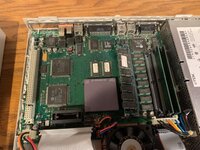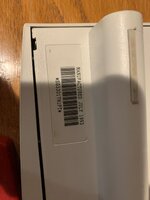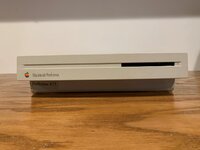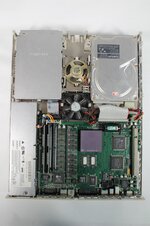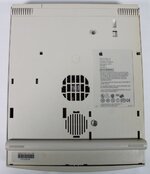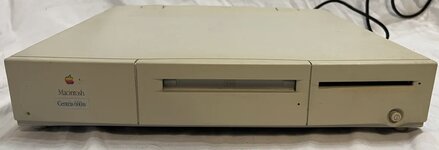nickpunt
Well-known member
I have a hypothesis: Apple intended to launch the LC 475 / Performa 475 / Quadra 605 sometime in late summer of 1993, such as August or Sept, rather than announcing in late October for sale in Nov-Dec.
This is an attempt to solve the mystery of many sightings of Performa 475's and LC 475's in the old snow white style topcase of LC I-III over the years, as well as a 'transition' espresso topcase. In fact, one is on eBay now (4/13/23), and one was just sold (4/1/23) - select images attached below. Officially these models were released Oct 18-21 1993, but both of these eBay listings have July 1993 build dates, as do other sightings. While one (serial # SG33017N1PT) shows an undistinguished 'Performa' label, the second (serial # SG33128Q12M) shows an 'LC 475' label, which is quite interesting, as it suggests Apple was ready to put these out in the market.

Reviewing all the possible hypotheses:
Some facts to consider:
I thought this would be interesting for those with interest in this model (@Danamania @MrFahrenheit and others?).
---
In summary, my full hypothesis is the exec transition to Spindler led to a request to redesign the 475/605 in Espresso ID both for style alignment and to align with the new manual-inject style floppies to cut costs, which delayed the launch from Aug/Sept to Oct. The ID team hastily redesigned just the front to satisfy that request, and later revised the top design for the full Espresso treatment. A small number of older style units were already manufactured, so they just shipped them, because it was the WTF era of Apple.
This is an attempt to solve the mystery of many sightings of Performa 475's and LC 475's in the old snow white style topcase of LC I-III over the years, as well as a 'transition' espresso topcase. In fact, one is on eBay now (4/13/23), and one was just sold (4/1/23) - select images attached below. Officially these models were released Oct 18-21 1993, but both of these eBay listings have July 1993 build dates, as do other sightings. While one (serial # SG33017N1PT) shows an undistinguished 'Performa' label, the second (serial # SG33128Q12M) shows an 'LC 475' label, which is quite interesting, as it suggests Apple was ready to put these out in the market.

Reviewing all the possible hypotheses:
- Replacements - they're upgrades/replacements/refurbs for older machines (discussed in a related thread).
- Pre-production - They're just non-labeled EVT DVT PVTs.
- Partners - They're from the initial production run meant for close partners (e.g. friendly software cos, schools, employees, etc), before the official launch.
- Inventory - Apple wanted to switch from snow white to espresso ID but had a large inventory of old topcases and/or auto-inject floppies, so chose to start with this style.
- Delayed Launch - They're from an initial but aborted production run. Perhaps this line was meant to be launched earlier, but was delayed several months.
Some facts to consider:
- Espresso transition - in 1993 Apple was transitioning from Snow White to Espresso ID. Several models were released earlier in the year like Centris 650, Color Classic, etc. This ID transition was gradual, as you can see systems that express some ideas of both.
- Espresso topcase revisions - The new espresso topcase went through two design revisions - one with the old style vertical lines, the other with a smaller number of curvier horizontal lines (see pic above). This may be supporting evidence for #5, as the 'transition' topcase could have been a hasty facelift due to the delay (e.g. new CEO Spindler says 'why are we still shipping snow white designs? redesign it before we launch!'), and they did so but they didn't have enough time to design & build tooling for the top until later.
- Floppy style change - sometime in 1993 apple switched from auto-inject to manual-inject style floppies. E.g. early Centris 650's had the auto-style + espresso, while later ones had the manual-style. If Apple wanted to do manual-style (e.g. due to inventory or customer complaints), that would have necessitated a hasty front facelift to add the cut-outs for pulling out floppies, supporting #4 and #5 above.
- Executive transition & layoffs - In June Scully left and Spindler became CEO. In July, Apple laid off 2500 (15% of staff). I think this strongly supports #5, as the product line may have been reconsidered, likely due to Apple's worsening finances. Any delay would also almost necessitate the Espresso change and the floppy change as manufacturing/inventory of both items dwindled (for either cost-cutting or just transition).
- Schools don't give a shit - An old topcase style wouldn't have bothered schools, lending slight credence to #3. However the existence of Performas (sold at retail) somewhat invalidates this.
- Time between manufacture and sale - There may be a 1-3 month delay between manufacturing and sale. Not sure how Apple was doing at that point, but it was definitely a pre-Tim Cook era supply chain with insufficient 'just in time' planning. This somewhat supports #4 as Apple may have been priming the manufacturing pipeline for later launch. However, 3+ months was a very long time in computing in this era.
- Pricing was possible - The Centris 610 came out in Feb 1993 @ $2520, tho by July 1993 was only $1688 (according to a MacUser ad). This depreciation was typical of the time, especially with Apple. The LC II (03/1992) was $1699, the LC III (02/1993) was $1349. Given this, it's plausible Apple could bring to market a cheaper LC-style 040 around July-August timeframe for ~$1200-1400. When it actually launched a few months later in 10/1993 it was only $1000. I think this supports #5, or at least doesn't rule it out from pricing end.
- Sold at retail - Among the previous sightings was @saybur 's discovery of a Performa with original packaging, suggesting an old topcase was sold that way (likely invalidating #2 and #3).
- LC III / III+ transition - LC III/III+ were also transitioned to new case design, lending credence to #4 as an inventory draw-down. If Apple was thinking, they would have just used the remaining inventory of old topcase styles on LC III/III+ systems (030 era ID with 030 era systems) rather than on the new 475/605 systems. Perhaps the exec shuffle got them to do this thinking and reroute old inventory to III/III+, which supports #5.
- WTF era - 1993 was peak 'WTF are they doing' Apple. They introduced and killed the Centris line, launched Newton, were prepping the PowerPC transition, transitioning ID, transitioning to CD-ROM era, adding DOS boards to systems, creating unnecessary SKUs (e.g. performa 475 and 476) so much it led to consumer confusion, etc. I love some of these systems but I think the inmates were running the Apple asylum at this time. A lot of the early talent was gone and they were in a leadership vacuum, so if anything, botching at least one launch because the left hand didn't know what the right hand was doing was likely in 1993.
- Does anyone know when exactly the auto-inject to manual-inject floppy transition occurred?
- The manufactured date is on the bottom case, not the topcase. Perhaps others have early espresso models with pre-October dates? My Performa 450 (serial # F13303T00S5) doesn't have a manufacture date unfortunately.
- What's the latest date of manufacture of LC III and III+ that we know? Tho these were sold in early 1994, they may have been queued up far earlier and just been running down stocks. This might support #3 and #4.
- Performa LC 475 oddity? Pre-production? Demo? by @unity (2016) - has many sightings of old topcase 475/605 series systems. This thread has a lot of great details in it, including those being manufactured in 30th week of 1993 (aka July).
- Are all Macintosh models without a name badge prototypes? by @MrFahrenheit (2020) - discusses unlabeled (likely PVT) LC style systems
- Apple History, 1993 - good timeline of what was going on in this transitional year in Apple's history.
- List of Mac Models on Wikipedia - timeline of launches and how long they were on the market. Wikipedia doesn't have great pricing info tho, as street prices varied widely and magazines are the best source of info.
I thought this would be interesting for those with interest in this model (@Danamania @MrFahrenheit and others?).
---
In summary, my full hypothesis is the exec transition to Spindler led to a request to redesign the 475/605 in Espresso ID both for style alignment and to align with the new manual-inject style floppies to cut costs, which delayed the launch from Aug/Sept to Oct. The ID team hastily redesigned just the front to satisfy that request, and later revised the top design for the full Espresso treatment. A small number of older style units were already manufactured, so they just shipped them, because it was the WTF era of Apple.
Attachments
Last edited:

